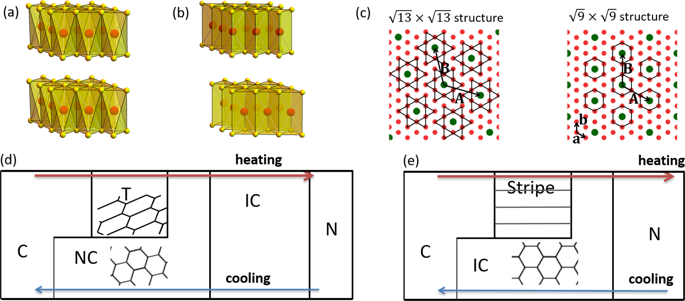Our official English website, www.x-mol.net, welcomes your
feedback! (Note: you will need to create a separate account there.)
Multivalley Free Energy Landscape and the Origin of Stripe and Quasi-Stripe CDW Structures in Monolayer MX2 Compounds.
Scientific Reports ( IF 3.8 ) Pub Date : 2020-01-27 , DOI: 10.1038/s41598-020-58013-7 Keiji Nakatsugawa 1, 2 , Satoshi Tanda 1, 2 , Tatsuhiko N Ikeda 3
Scientific Reports ( IF 3.8 ) Pub Date : 2020-01-27 , DOI: 10.1038/s41598-020-58013-7 Keiji Nakatsugawa 1, 2 , Satoshi Tanda 1, 2 , Tatsuhiko N Ikeda 3
Affiliation

|
Ultrathin sheets of transition metal dichalcogenides (MX2) with charge density waves (CDWs) is increasingly gaining interest as a promising candidate for graphene-like devices. Although experimental data including stripe/quasi-stripe structure and hidden states have been reported, the ground state of ultrathin MX2 compounds and, in particular, the origin of anisotropic (stripe and quasi-stripe) CDW phases is a long-standing problem. Anisotropic CDW phases have been explained by Coulomb interaction between domain walls and inter-layer interaction. However, these models assume that anisotropic domain walls can exist in the first place. Here, we report that anisotropic CDW domain walls can appear naturally without assuming anisotropic interactions: We explain the origin of these phases by topological defect theory (line defects in a two-dimensional plane) and interference between harmonics of macroscopic CDW wave functions. We revisit the McMillan-Nakanishi-Shiba model for monolayer 1T-TaS2 and 2H-TaSe2 and show that CDWs with wave vectors that are separated by 120° (i.e. the three-fold rotation symmetry of the underlying lattice) contain a free-energy landscape with many local minima. Then, we remove this 120° constraint and show that free energy local minima corresponding to the stripe and quasi-stripe phases appear. Our results imply that Coulomb interaction between domain walls and inter-layer interaction may be secondary factors for the appearance of stripe and quasi-stripe CDW phases. Furthermore, this model explains our recent experimental result (appearance of the quasi-stripe structure in monolayer 1T-TaS2) and can predict new CDW phases, hence it may become the basis to study CDW further. We anticipate our results to be a starting point for further study in two-dimensional physics, such as explanation of "Hidden CDW states", study the interplay between supersolid symmetry and lattice symmetry, and application to other van der Waals structures.
中文翻译:

单层MX2化合物中的多谷自由能景观和条纹和准条纹CDW结构的起源。
带有电荷密度波(CDW)的超薄过渡金属二硫化碳(MX2)薄片正逐渐成为人们感兴趣的石墨烯类器件的候选材料。尽管已经报道了包括条纹/准条纹结构和隐藏状态的实验数据,但是超薄MX2化合物的基态,尤其是各向异性(条纹和准条纹)CDW相的起源是一个长期存在的问题。各向异性CDW相已通过畴壁之间的库仑相互作用和层间相互作用来解释。但是,这些模型假定各向异性畴壁可以首先存在。在这里,我们报告各向异性CDW畴壁可以自然出现而无需假设各向异性相互作用:我们通过拓扑缺陷理论(二维平面中的线缺陷)和宏观CDW波函数的谐波之间的干扰来解释这些相的起源。我们重新研究了单层1T-TaS2和2H-TaSe2的McMillan-Nakanishi-Shiba模型,并显示了波矢量相隔120°(即下层晶格的三重旋转对称性)的CDW包含自由能景观与许多当地的最低要求。然后,我们消除了这个120°约束,并表明出现了对应于条纹和准条纹相的自由能局部极小值。我们的结果表明,畴壁之间的库仑相互作用和层间相互作用可能是条纹和准条纹CDW相出现的次要因素。此外,该模型解释了我们最近的实验结果(单层1T-TaS2中准条纹结构的出现)并可以预测新的CDW相,因此它可能成为进一步研究CDW的基础。我们预计我们的结果将成为二维物理学进一步研究的起点,例如“隐式CDW态”的解释,研究超固体对称性和晶格对称性之间的相互作用以及在其他范德华结构中的应用。
更新日期:2020-01-27
中文翻译:

单层MX2化合物中的多谷自由能景观和条纹和准条纹CDW结构的起源。
带有电荷密度波(CDW)的超薄过渡金属二硫化碳(MX2)薄片正逐渐成为人们感兴趣的石墨烯类器件的候选材料。尽管已经报道了包括条纹/准条纹结构和隐藏状态的实验数据,但是超薄MX2化合物的基态,尤其是各向异性(条纹和准条纹)CDW相的起源是一个长期存在的问题。各向异性CDW相已通过畴壁之间的库仑相互作用和层间相互作用来解释。但是,这些模型假定各向异性畴壁可以首先存在。在这里,我们报告各向异性CDW畴壁可以自然出现而无需假设各向异性相互作用:我们通过拓扑缺陷理论(二维平面中的线缺陷)和宏观CDW波函数的谐波之间的干扰来解释这些相的起源。我们重新研究了单层1T-TaS2和2H-TaSe2的McMillan-Nakanishi-Shiba模型,并显示了波矢量相隔120°(即下层晶格的三重旋转对称性)的CDW包含自由能景观与许多当地的最低要求。然后,我们消除了这个120°约束,并表明出现了对应于条纹和准条纹相的自由能局部极小值。我们的结果表明,畴壁之间的库仑相互作用和层间相互作用可能是条纹和准条纹CDW相出现的次要因素。此外,该模型解释了我们最近的实验结果(单层1T-TaS2中准条纹结构的出现)并可以预测新的CDW相,因此它可能成为进一步研究CDW的基础。我们预计我们的结果将成为二维物理学进一步研究的起点,例如“隐式CDW态”的解释,研究超固体对称性和晶格对称性之间的相互作用以及在其他范德华结构中的应用。











































 京公网安备 11010802027423号
京公网安备 11010802027423号